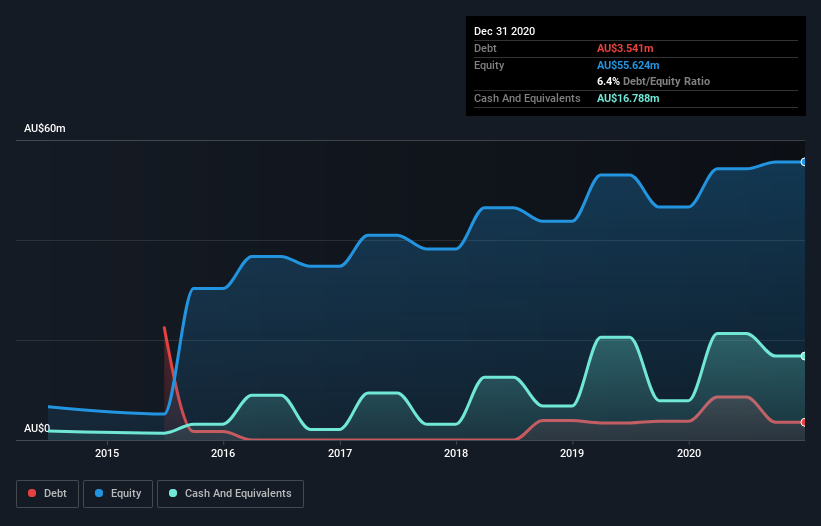Does PWR Holdings (ASX:PWH) Have A Healthy Balance Sheet?
David Iben put it well when he said, 'Volatility is not a risk we care about. What we care about is avoiding the permanent loss of capital.' When we think about how risky a company is, we always like to look at its use of debt, since debt overload can lead to ruin. We can see that PWR Holdings Limited (ASX:PWH) does use debt in its business. But should shareholders be worried about its use of debt?
Why Does Debt Bring Risk?
Debt assists a business until the business has trouble paying it off, either with new capital or with free cash flow. If things get really bad, the lenders can take control of the business. However, a more common (but still painful) scenario is that it has to raise new equity capital at a low price, thus permanently diluting shareholders. Of course, plenty of companies use debt to fund growth, without any negative consequences. The first step when considering a company's debt levels is to consider its cash and debt together.
Check out our latest analysis for PWR Holdings
What Is PWR Holdings's Debt?
You can click the graphic below for the historical numbers, but it shows that PWR Holdings had AU$3.54m of debt in December 2020, down from AU$3.75m, one year before. But it also has AU$16.8m in cash to offset that, meaning it has AU$13.2m net cash.
A Look At PWR Holdings' Liabilities
Zooming in on the latest balance sheet data, we can see that PWR Holdings had liabilities of AU$13.1m due within 12 months and liabilities of AU$14.1m due beyond that. Offsetting these obligations, it had cash of AU$16.8m as well as receivables valued at AU$7.04m due within 12 months. So its liabilities outweigh the sum of its cash and (near-term) receivables by AU$3.32m.
Having regard to PWR Holdings' size, it seems that its liquid assets are well balanced with its total liabilities. So it's very unlikely that the AU$617.1m company is short on cash, but still worth keeping an eye on the balance sheet. While it does have liabilities worth noting, PWR Holdings also has more cash than debt, so we're pretty confident it can manage its debt safely.
On the other hand, PWR Holdings's EBIT dived 16%, over the last year. If that rate of decline in earnings continues, the company could find itself in a tight spot. There's no doubt that we learn most about debt from the balance sheet. But it is future earnings, more than anything, that will determine PWR Holdings's ability to maintain a healthy balance sheet going forward. So if you're focused on the future you can check out this free report showing analyst profit forecasts.
Finally, a business needs free cash flow to pay off debt; accounting profits just don't cut it. While PWR Holdings has net cash on its balance sheet, it's still worth taking a look at its ability to convert earnings before interest and tax (EBIT) to free cash flow, to help us understand how quickly it is building (or eroding) that cash balance. Over the most recent three years, PWR Holdings recorded free cash flow worth 69% of its EBIT, which is around normal, given free cash flow excludes interest and tax. This cold hard cash means it can reduce its debt when it wants to.
Summing up
We could understand if investors are concerned about PWR Holdings's liabilities, but we can be reassured by the fact it has has net cash of AU$13.2m. The cherry on top was that in converted 69% of that EBIT to free cash flow, bringing in AU$16m. So we are not troubled with PWR Holdings's debt use. The balance sheet is clearly the area to focus on when you are analysing debt. However, not all investment risk resides within the balance sheet - far from it. For example - PWR Holdings has 1 warning sign we think you should be aware of.
If, after all that, you're more interested in a fast growing company with a rock-solid balance sheet, then check out our list of net cash growth stocks without delay.
This article by Simply Wall St is general in nature. It does not constitute a recommendation to buy or sell any stock, and does not take account of your objectives, or your financial situation. We aim to bring you long-term focused analysis driven by fundamental data. Note that our analysis may not factor in the latest price-sensitive company announcements or qualitative material. Simply Wall St has no position in any stocks mentioned.
Have feedback on this article? Concerned about the content? Get in touch with us directly. Alternatively, email editorial-team (at) simplywallst.com.

 Yahoo Finance
Yahoo Finance 
